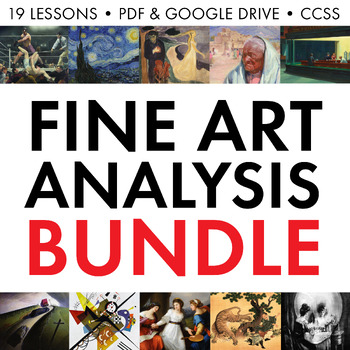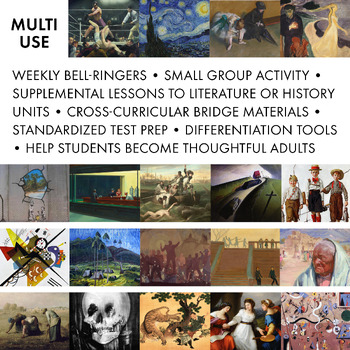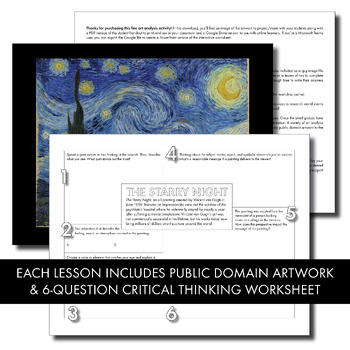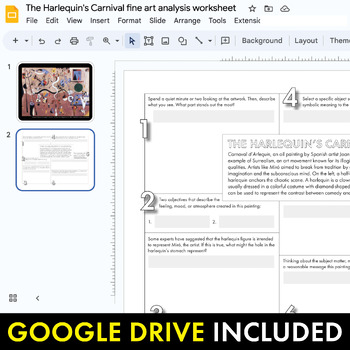Fine Art Analysis Bundle, Art Supplements, Critical Thinking Bell-Ringers, CCSS
- Zip
- Google Apps™

What educators are saying
Description
Help students hone their critical thinking and analysis skills with this collection of fine art bell-ringers (Masterpiece Monday? Fine Art Friday?) and/or literature or history unit supplemental lessons. Each of the 19 lessons is available for individual purchase (see links below), but you’ll save more than 20 percent if you purchase this bundle – the same as getting four free lessons!
Each lesson includes both a printable PDF and interactive Google Drive version of the student worksheet along with a high-resolution PDF, JPG image, and Google Slide version of each public domain artwork.
Featured artwork includes: (click link to view individual product page):
1. George Bellows’ Dempsey and Firpo
2. Vincent van Gogh’s The Starry Night
7. John Singleton Copley’s Watson and the Shark
8. Grant Wood’s Death on Ridge Road
9. Norman Rockwell’s The Fishing Trip
10. Wassily Kandinsky’s On White II
11. Emily Carr’s Odds and Ends
12. Aaron Douglas’ Aspects of Negro Life: From Slavery to Reconstruction
14. Gerald Cassidy’s Antonio Concha, Old Man of Taos
15. Jean-Francois Millet’s The Gleaners
16. C. Allan Gilbert’s All is Vanity
17. Katsushika Hokusai’s Filial Piety: Yang Hsiang Saving his Father from a Tiger
18. Angelica Kauffman’s Self-Portrait Hesitating Between Painting and Music
19. Joan Miró’s Carnaval d’Arlequin (The Harlequin’s Carnival)
A few suggested uses:
1. Use these materials as a weekly bell-ringer to begin class. Project the artwork slide as students enter your classroom to catch their attention. Once class begins, assign students to work alone or in teams of two to complete the handout questions while you take attendance and get ready for the class period. After students have had enough time to write their answers (usually five to seven minutes or so), pull the class together for a full-class discussion. Note: A typical semester runs 18 weeks, but I’ve included 19 lessons in this bundle in case you prefer to skip one for whatever reason.
2. Assign the worksheet as a traditional homework assignment. Launch the discussion mentioned in #1 at the beginning of the next class period.
3. Use the materials to supplement a study of any piece of literature that’s thematically related or any history unit from the same era as the artwork’s creation. If possible, ask students to use their 1:1 devices to research world events from the same year and/or information about the artist’s life. How might have global events influenced the artist and this particular work of art?
4. Use as part of a jigsaw activity. Move students into groups of three and give each group a different piece of art to analyze. Once the small groups have discussed the worksheet questions, have them present the artwork slide and their discoveries to the full class as a mini-presentation.
5. Use as part of an emergency sub plan.
Please note: Answer keys are not included, as students’ responses will vary and any reasonable response would earn credit in my class. These materials were designed to be used as a class warm-up/conversation starter more than an assessed assignment.
Already recently purchased some of these items?
No worries – you don’t have to double-pay. After you purchase this discounted bundle, let the TpT customer service folks know about individual items you’ve previously purchased via the refund request form here – https://www.teacherspayteachers.com/Contact – and they’ll refund the cost of the individual items once they confirm your account history that shows the double-purchase. Please note that the maximum total refund that can be given is the cost of the bundle and that any refund requests must be submitted within one year of your purchase of the individual item/s. If you purchased items prior to a year ago, they will not qualify for a refund per TpT policy.
Licensing:
This purchase includes a license for just one teacher to use the materials solely with the teacher’s direct students. This resource cannot be shared with colleagues or used by an entire school or district without purchasing the appropriate number of licenses.
Copyright:
The licensing agreement from TpT and copyright law prevent you from posting any of these materials online in any form. Posting of materials may happen ONLY within a password-protected environment intended to be accessed solely by your direct students, such as Google Classroom, MSTeams, or Canvas. Posting on public websites (WordPress, Weebly, Wix, etc.) or within shared drives or social media groups is prohibited.
I hope your students enjoy stretching their critical thinking skills with these fine art analysis materials. Thanks for stopping by!





